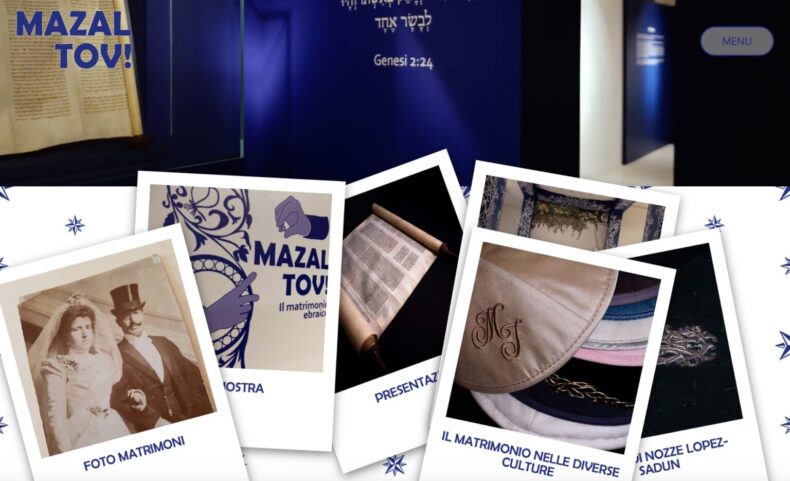Jewish weddings rites and history, MEIS exhibition goes online

The MEIS exhibition “Mazal Tov! The Jewish marriage” is now online. The project, curated by Sharon Reichel and Rabbi Amedeo Spagnoletto, illuminates a fundamental passage of Jewish life, which is nurtured by precepts and rites of the past, represents an emblem of continuity, is rotted in the Bible, and yet, in marking the birth of a new family, dialogues with a vibrant present and the culture in which it is immersed. “Mazal Tov!” exposes this very balance between ancient and modern, combining precious documents with works of contemporary art.
In addition to a virtual tour, it is possible to deepen different aspects of the rite, from the wedding contract (ketubbah) to the meanings of the symbolic breaking of the glass at the end of the ceremony. In addition to this, just a click away there are unpublished videos and a photo gallery dedicated to Italian Jewish weddings from the end of the nineteenth century to recent times.
The online exhibition was presented last week in Rome in a meeting held in the auditorium of the Pontifical John Paul II Institute for Marriage and Family Sciences. “We are convinced that dialogue, like peace, must be built every day. Not with proclamations and grand statements, but by sharing real moments like this”, pointed out Milena Santerini, national coordinator for the fight against antisemitism at the Presidency of the Council of Ministers, who introduced and coordinated the event. In this sense, she highlighted, marriage and family are themes “that can help mutual understanding because they evoke images of life, happiness, the future”.
On the same wavelength Monsignor Vincenzo Paglia, president of the Pontifical Academy for Life, spoke of “indispensable relationality between the different religious traditions” and hoped to continue along this path “with other meetings”.
As the Chief Rabbi of Rome Riccardo Di Segni remarked, considering the recent debate in Italy about the double surname, the exhibition is strictly related to our time. It is an excellent opportunity, for example, to analyze the concepts of “patrilineality and matrilineality”, the latter being a cornerstone of Judaism.
This is an exhibition “good for the heart”, as remarked Rabbi Spagnoletto at the opening. It was the spring of 2021, and after months of forced closure due to the pandemic the National Museun of Italian Judaism and the Shoah celebrated its reopening with this joyful initiative. “Marriage – he pointed out – is one of the deepest acts of love and trust in regards to the future and it brings with it a message of universal hope, a balm for the complex time in which we currently live”.
“After having had so many visitors and experienced their curiosity and interest – he explained – we decided to realize a digital version of ‘Mazal Tov!’ so to create a permanent exhibition accessible to a wider public, aimed at those who want to find out more about rites and traditions after reading a book or seen a film, students who want a platform from which to start their research, and those who wanted to visit it but did not have the opportunity”, remarks MEIS director Rabbi Spagnoletto.
It is a valuable opportunity to explore a glorious tradition since as curator Sharon Reichel explained to Pagine Ebraiche, the exhibition follows two directions. “On one hand there are objects linked to the rite; on the other, the various forms of expression surrounding marriage, collected under the voice ‘customs and traditions. The purpose is to display objects related to personal stories, which concretely show that the value of an artifact could be both artistic and cultural “. “With this exhibition, – concludes the curator – we wanted to deepen the relationship that binds objects to people and, together with historical artifacts, we decided to open some windows on the contemporary world to make a tangible understanding of how Judaism is a living religion and culture. Often, visitors who come to our museum talk about the Jews in the past tense, we want them to start doing so in the present tense and, why not, also in the future”.
